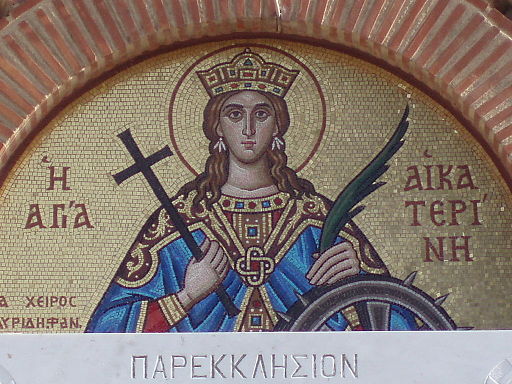

Catherine's patronage divides according to the major features of her hagiographical story:
(1) Holy Learning: According to the old legend, Catherine had studied the full panoply of studies available in the schools of Alexandrian Platonism; when pagan philosophers and orators were brought in to try to convert her, she outargued them all. All the Alexandrian saints tend to be intellectual in one way or another; St. Catherine in a sense sums them all up, as Christian Alexandria personified. Because of this, she is patron of philosophers, theologians, apologists, preachers, archivists and librarians, educators, jurists and lawyers, nurses, students (especially female students), scribes, secretaries and stenographers -- in short all those who live lives of the mind, however great and small, however theoretical or applied. In the medieval university, especially at the University of Paris (of which she was the patron), St. Catherine's Day was a big, big deal.
(2) The Wheel: The most famous element of her hagiographical legend was the attempt to kill her by breaking her on the wheel; it was the wheel instead that was broken. Since St. Catherine was an extremely popular saint in the Middle Ages, and well into the Renaissance, you can find her picture all over the place -- and usually you can pick her out by the fact that she wears a crown, has a book (occasionally some other instrument of learning, like a quill pen), and has a wheel (on occasions a sword is substituted for the wheel, since she was decapitated, and she often has a palm branch, but this is common to martyrs generally). On occasion one of these will be dropped, but rarely will you find her without at least two. Because of her association with the wheel, she is the patron of potters, spinners, knife sharpeners, mechanics, etc.
(3) The Maiden: For literally centures, St. Catherine was one of the most prominent and popular female saints. When artists wanted to show saints in attendance of the Virgin Mary, St. Catherine was always a prime candidate. Because of this she is a special patron of women: girls, female teachers and students, maidens, and spinsters.
As I noted above, the iconography and hagiography of St. Catherine really is a rather significant portion of our cultural heritage; even if you are non-Catholic and have no interest in hagiographical patronage, being a Westerner unable to look at a painting and pick out St. Catherine, a visually distinctive saint found throughout art and literature, is quite literally almost as absurd as being unable to identify the Virgin Mary. It's a sign of the artistic equivalent of illiteracy. But such is what we've largely come to, I suppose.
